Table of contents
- PS reader question about motorcycle technology Translation for the racetrack
- Not all gear steps must be used?
- Shift as little as possible in complicated sections of the route
- Create translation table
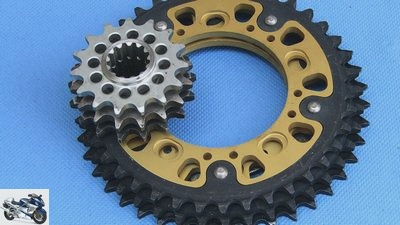
Werner Koch
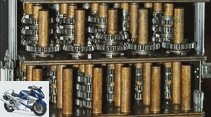
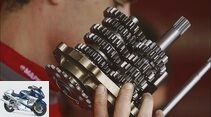
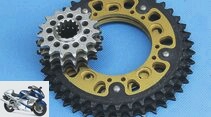
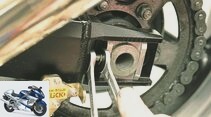
14th pictures
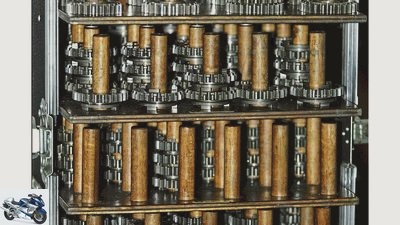
factstudio.de
1/14
How do you find the right translation for the racetrack?
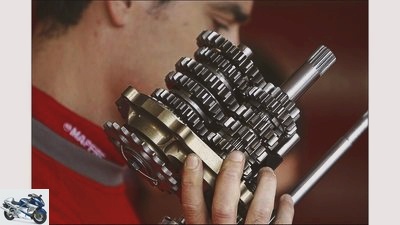
factstudio.de
2/14
Quick change transmissions in GP sport allow the individual gear steps to be optimally adapted to the route layout. However, countless gear pairs are necessary for this.
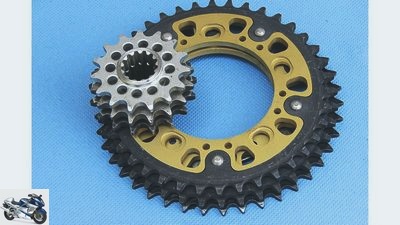
Mini cook
3/14
In the case of series motorcycles, the appropriate gear ratio is produced in the combination of pinion (front) and chain wheel (rear). However, this changes the wheelbase and chain tension.
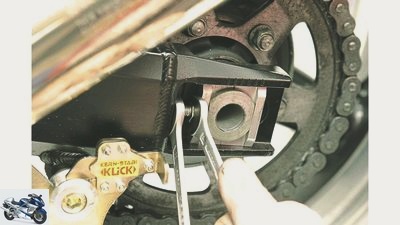
Schermer
4/14
Whenever the pinion or sprocket is changed, the chain tension must be checked and readjusted. Which also changes the wheelbase and weight distribution to a greater or lesser extent.
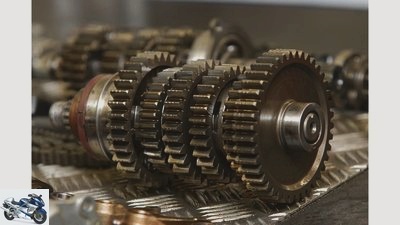
Katrin Sdun
5/14
The right translation for the racetrack.
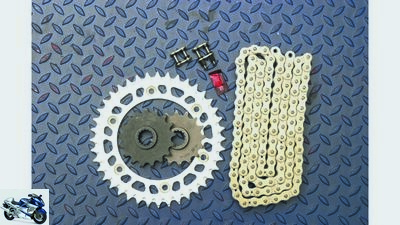
Schermer
6/14
Theoretically, the final ratio should be chosen so that you turn the last gear on the longest straight just before the braking point or even “stand” in the limiter for a short moment.

Schermer
7/14
The formula according to which the last gear should turn out in the fastest section, however, only applies to bikes with an output significantly below 100 hp.
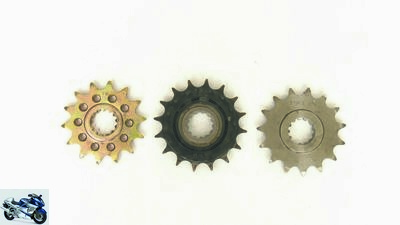
Schermer
8/14
In MotoGP, the technicians only change the sprockets in very few cases, but adapt the individual gear stages and the primary gear ratio to the route.
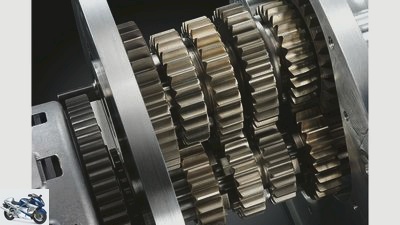
Heinz Mitterbauer
9/14
Whereby the immense power surplus of the roughly 260 hp machines means that the drivers do not necessarily use all gears. For example, only four gears are used on the tight GP circuit in Valencia.
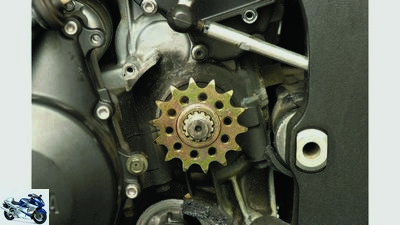
Schermer
10/14
This measure also applies to the hobby racer with a powerful 1000cc engine. So when choosing the gear ratio you should make sure that you have to change gears as little as possible in complicated sections of the route.
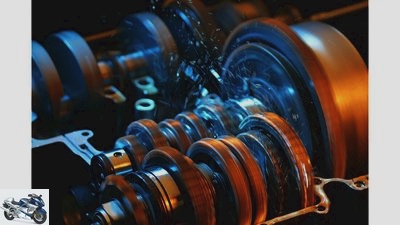
archive
11/14
You can also choose the secondary ratio so that you do without sixth gear and instead drive through the sections smoothly and smoothly.
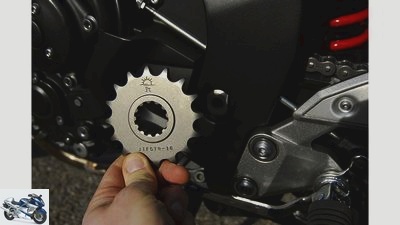
Andreas Holzer
12/14
Since the current 1000 series is geared to 300 km / h as standard, you can generally drive one tooth smaller at the front (wheelbase is around 8 mm longer) and three teeth larger at the rear
(Wheelbase is around 24 mm shorter with the same chain length).

factstudio.de
13/14
If you are serious about playing with the translation and want to improve your lap times, you should create a translation table in order to compare the various translation options (sprockets / chainrings) with the individual gear steps and the speed.
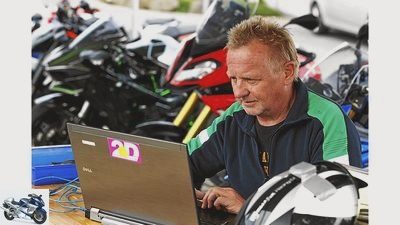
factstudio.de
14/14
Very important to note: the rolling circumference on the rear wheel, which can vary greatly depending on the dimension and tire type and thus of course influences the final gear ratio.
counselor
technology & future
PS reader question about motorcycle technology – translation for the racetrack
PS reader question about motorcycle technology
Translation for the racetrack
Content of
PS reader Gerald Knitt would like to know how to find the right translation for the racetrack. PS technology expert Werner Koch gives the answer.
Werner Koch
08/09/2016
Hello Gerald, theoretically, the final gear ratio should be chosen so that you have turned the last gear on the longest straight just before the braking point or even “stand in” for a short moment in the limiter. This means that you have the highest possible tractive effort on the rear wheel in the acceleration phase. This pulling force is the decisive factor in acceleration. The formula according to which the last gear should turn out in the fastest section, however, only applies to bikes with an output significantly below 100 hp. This is why the around 55 hp Moto3 machines use all six gears available on almost all routes.
Buy complete article
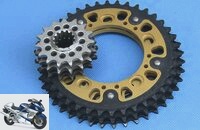
PS reader question about motorcycle technology
Translation for the racetrack
2 pages) as PDF
€ 2.00
Buy now
However, here, too, care is taken to ensure that the engine can accelerate out of bends at the optimal speed onto a subsequent long straight in order to keep the speed perfectly. With this fine-tuning, drivers in the smallest class can not only adjust the overall ratio between pinion and rear wheel (secondary drive), but also the respective gear steps in the transmission. In addition, the 2016 regulations allow the use of three different primary ratios, i.e. the gear configuration between the crankshaft and the clutch basket (primary drive).
Not all gear steps must be used?
This trick allows the secondary drive consisting of the pinion and chainring to be retained for many racetracks. Because the diameter of the chain sprocket / chainring has a decisive influence on the forces and reactions of the chain hoist, the so-called “anti-squating”, and you don’t want to change that. This anti-squating prevents the motorcycle from dipping at the rear when accelerating and the steering geometry from changing to the disadvantage.
In contrast, the primary and gear wheels of the 600 series Supersport and Moto2 motorcycles are fixed, so the gear ratio can only be changed using the secondary drive. In MotoGP, the technicians only change the sprockets in very few cases, but adapt the individual gear stages and the primary gear ratio to the route. The immense excess power of the roughly 260 hp machines means that the drivers do not necessarily use all gears. For example, only four gears are used on the tight GP circuit in Valencia. In Brno it is assumed that Rossi and Co. only use the three upper gears. Of course, this is only possible because the 1000s have an extremely wide usable speed range, in which any unnecessary gear changes could disturb the ideal line of the pilots despite the seamless transmission.
Shift as little as possible in complicated sections of the route
This measure also applies to the hobby racer with a powerful 1000cc engine. So when choosing the gear ratio you should make sure that you have to change gears as little as possible in complicated sections of the route. You can also choose the secondary ratio so that you do without sixth gear and instead drive through the sections smoothly and smoothly.
Since the current 1000 series are geared to 300 km / h as standard, you can generally drive one tooth smaller at the front (wheelbase is around 8 mm longer) and three teeth larger at the rear (wheelbase is around 24 mm shorter with the same chain length). This change not only improves the acceleration subjectively, but also measurably, without reducing the maximum speed that can be achieved on the racetrack.
Create translation table
If you are serious about playing with the translation and want to improve your lap times, you should create a translation table in order to compare the various translation options (sprockets / chainrings) with the individual gears and the speed. Very important to note: the rolling circumference on the rear wheel, which can vary greatly depending on the dimension and tire type and thus of course influences the final gear ratio.
And don’t forget: a translation that perfectly matches the layout of the racetrack during training can be a tad too short in the race – if the going really gets to the point.
Related articles
-
PS reader question about motorcycle technology – cleaning the radiator
www.factstudio.de, Joachim Schahl 7th pictures archive 1/7 Picture gallery, technical question: cleaning coolers. Werner Koch 2/7 When the delicate…
-
Technology: The load change on a motorcycle
Drawing: archive counselor technology & future Technology: The load change on a motorcycle Technology: motors / drive The load change on a motorcycle…
-
PS reader question about motorcycle technology
jkuenstle.de counselor technology & future PS reader question about motorcycle technology PS reader question about motorcycle technology Beam or banana…
-
PS reader question on motorcycle technology – tire wear on the racetrack
jkuenstle.de 5 pictures markus-jahn.com 1/5 “What is the reason for the flaky, frayed way in which racing tires are destroyed??”, asks us reader Holger…
-
MOTORCYCLE tips for racetrack training
jkuenstle.de counselor workshop MOTORCYCLE tips for racetrack training Tips for newcomers to the racetrack Always nice and slow You’ve got your hands on…
-
PS reader question about motorcycle technology crash pads
Henniges 7th pictures Wiessmann 1/7 Picture gallery, technology: Are crash pads in makes sense in each case? Katrin Sdun 2/7 These crash pads are not…
-
PS reader question about ergonomics on the motorcycle
jkuenstle.de Sports & scene Motorsport PS reader question about ergonomics on the motorcycle PS reader question about ergonomics on the motorcycle Sits,…
-
PS-Technik reader question Mount heat protection on the manifold
Cook counselor technology & future PS-Technik reader question Mount heat protection on the manifold Technology: Mount the heat protection on the manifold…
-
counselor technology & future Technology: belt drive technology Belt drive Full automation instead of full employment, just step on the gas instead of…
-
fact motorcycles Technology: automatic Technology: automatic Automatic transmission Our everyday life is becoming more and more complex, and at the same…